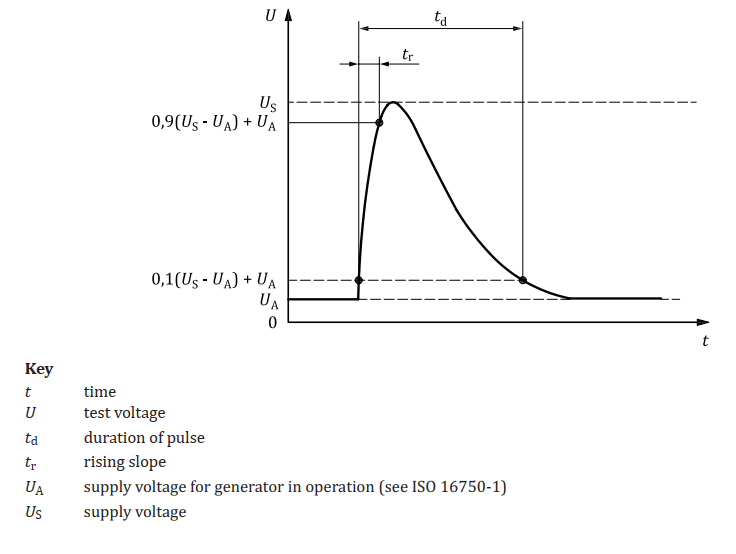
ISO 16750-2: Road Vehicles: Environmental Conditions and Testing for Electrical and Electronic...
Standard Overview
ISO 16750 applies to electric and electronic systems and components for vehicles. ISO 16750-2 more specifically refers to road vehicles and their environmental conditions and electrical equipment testing.
ISO 16750
ISO 16750 focuses on the potential environmental consequences and highligh
ts tests and requirements that are recommended for the specific mounting location on the vehicle. Several environmental factors were considered in the creation of the ISO 16750 series including world geography and climate, type of vehicle, vehicle use conditions and operating modes, equipment life cycle, vehicle supply voltage, and mounting location.
Types of Testing for ISO 16750 Complience
- Testing generator regulator failure
- Simulating jump start
- Superimposing voltage
- Superimposing sinusoidal voltage
- Evaluating the effect of momentary drop in supply voltage
- Completeing frequency sweeping
- Verifing the DUT reset behaviour at different voltage drops
- Checking the resistance of the DUT
- Running other supply voltage tests
ISO 16750-2
ISO 16750-2 is a subsection of the ISO 16750 standard in the general category of road vehicles for environmental conditions, electrical equipment testing, and electronic equipment testing. ISO 16750-2 describes the potential environmental stresses and specifies tests and requirements recommended for the specific mounting location on/in the road vehicle. Independent of the mounting location, electrical loads vary based on a vehicle wiring harness and connection system's electrical resistance.
Direct current supply voltage
Direct current supply voltage is something to consider when authenticating equipment functionality at the minimum and maximum supply voltage:
Table 1 - Supply voltage for system devices with 12 V nominal voltage
|
Code |
Minimum supply voltage (UsminV) |
Maximum supply voltage, (UsmaxV) |
|
A |
6 |
16 |
|
B |
8 |
16 |
|
C |
9 |
16 |
|
D |
10.5 |
16 |
Table 2 - Supply voltage for system devices with 24 V nominal voltage
|
Code |
Minimum supply voltage (UsminV) |
Maximum supply voltage, (UsmaxV) |
|
E |
10 |
32 |
|
F |
16 |
32 |
|
G |
22 |
32 |
|
H |
18 |
32 |
Load Dump Transient of ISO 16750-2
_19.png)
The Load Dump pulse, as seen above, is specified to simulated an automotive system in which the battery is disconnected, while the alternator is providing a charging current in circuit.
Reversed Voltage
This test is to verify functionality of an automotive system in which the battery is connected at the opposite terminals. Transient Generators are not required to accomplish this, but a DC Source or Battery would be required.
ISO 16750-2 Test Equipment
ISO 16750-2 is approved by the Technical Committee ISO/TC 22 and Subcommittee SC 3. For more information please contact our technical experts at Advanced Test Equipment Corporation to discuss your testing requirements. Further testing is required per ISO 16750-2 and can be found by purchasing the standard here.
Products Used in Testing

EM Test VDS 200N30 Voltage Drop Simulator | 60 V, 30 A
- Voltage up to 60 V
- Current up to 30A
- Bipolar-amplifier models available


AE Techron DSR 100-200 | Pulse 2B and 4
- Frequency Range: DC - 250 kHz
- Output Current: 0A - 200A (Cont.)
- DO 160G, ISO 7637-2, MIL STD 461F


EM Test LD 200N Load Dump Generator
- Pulse Duration: 10 ms - 1200 ms
- Rise time: <1 µs - 10 ms
- Internal resistance: 0.5 - 38 Ω


Teseq NSG 5500 Automotive Transient Immunity Tester for ISO 7637


AE Techron 8704 Linear Power Amplifier
- Frequency Range: DC – 250kHz
- Max Power Output: <4kW continuous
- Slew Rate: <300V/µs


AE Techron 7228 Linear Power Amplifier
- Frequency Range: DC – 1MHz
- AC Power: 1000W RMS
- Slew rate: 100 V/μs


AE Techron 7782 RMS Power Amplifier
- Frequency Range: DC – 50 kHz at full power
- Max Power Output: 3305 W RMS (2 Ω)
- Slew Rate: 40V/μs


AE Techron 7136 AC/DC Amplifier with Precision DC Power Supply
- Frequency Range: DC – 400kHz
- Max Power Output: 900W RMS (AC)
- Slew Rate: 165 V/µs


AE Techron 9110 Amplifier
- Frequency Range: DC – 250kHz (–3 dB)
- Max Power Output: 5kW
- Slew Rate: <300V/µs


AE Techron 7796 DC Power Amplifier
- DC – 30kHz (100kHz at reduced power)
- 22,000W peak (40mSec, 0.5Ω load)
- Slew Rate: 41V/µs


AE Techron 7794 4-Quadrant Power Amplifier
- Frequency Range: DC – 150kHz
- Max Power Output: 5,000W RMS (continuous)
- Slew Rate: 41V/µs


AE Techron 7224 Linear Power Amplifier
- Frequency Range: DC – 300kHz
- Max Output Power: 1,100W RMS
- Slew Rate: 75V/µs


AE-Techron 7796HC DC Power Amplifier
- Frequency Range: DC – 150kHz
- Max Power: 2,499W RMS continuous
- Slew Rate: 41V/µs


AE Techron 8500 Series Amplifiers
- Bandwidth: DC - 50kHz
- Power: 4 - 20kW
- Slew Rate: 60V/µs


BOLAB 100-TS Series
- Frequency Range: DC – 1 MHz
- Output: 400 W – 18000 W
- For LV124/VW80000, LV148, ISO 16750, ISO 7637, DIN 40839, & GS 95024


BOLAB Systems BLS-130-70N-TS 4-Quadrant Voltage Amplifier
- Frequency Range: DC – 1 MHz
- Max Output Power: 3,000 W
- For LV124 / VW80000, LV148, ISO 16750, ISO 7637, DIN 40839, GS 95024
